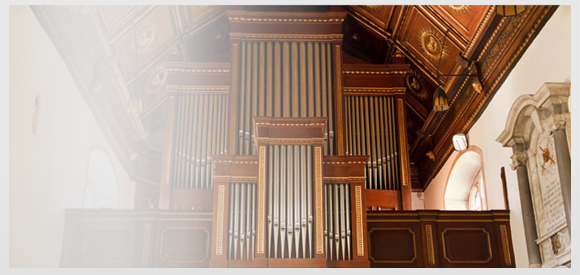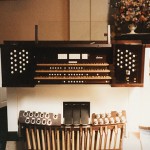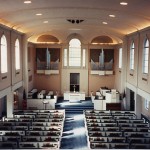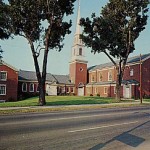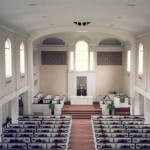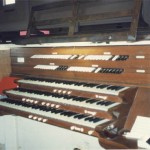First Christian Church
The congregation was organized by eleven charter members on November 19, 1871, in Clippinger’s Hall on the west side of Market Street, following a city-wide revival. Chattanooga was then a struggling young city of 7,000 inhabitants who had survived floods, fires, epidemics and financial panic. In 1885, the 188-member congregation built its first permanent home, an attractive building with a tall spire, between 7th and 8th Streets; it was dedicated on November 10, 1886, and was known as Walnut Street Christian
Church.
In 1901, the congregation moved to the corner of Georgia and 7th into a structure purchased from First Presbyterian Church. The congregation then changed its name to First Christian Church. On May 25, 1952, the present 550-seat Georgian Colonial building on McCallie Avenue was dedicated.
The church’s first organ was the 1877 John Fernquist organ inherited with the facility that the congregation purchased from First Presbyterian in 1907. Fernquist, an elder in the Presbyterian congregation and described in a 1910 newspaper article as a Swedish-born organbuilder, built the organ himself for his church’s then-present sanctuary. It was known for its pipes “gilded with pure gold.” The organ was rebuilt and enlarged when moved in 1884 to First Presbyterian’s new sanctuary at Georgia and Seventh. The Fernquist organ remained until First Christian replaced it with a 5-rank Wicks, Opus 2382, in 1941.
The new McCallie Avenue sanctuary of First Christian Church had a new 3-manual 12-rank Reuter, Opus 983. The prepared-for Choir division of six ranks and seven other ranks were added shortly thereafter. The organ was redone by Randall Dyer in 1989, retaining 13 ranks from the Reuter. The Great 8′ Principal and Pedal 4′ Choralbass are displayed in front of the organ chambers, which are located to each side of the central chancel window.
In the late 1990’s, Barger & Nix added a high-pressure hooded trumpet built by A. R. Schopp’s Sons. The stop was given by Robert V. Curtis in honor of his wife, Eloise, who served as organist of the church for nearly 40 years.
Reuter, 3/25, Op. 983, 1952
GREAT
8′ Diapason
8′ Claribel Flute
8′ Viola
8′ Gemshorn
4′ Octave
4′ Flauto Traverso 12
III Mixture
Tremolo
Sub
Unison Off
Super
Chimes
SWELL
16′ Flute Conique
8′ Geigen Diapason
8′ Rohrflote 12
8′ Viole de Gambe
8′ Viole Celeste tc
8′ Spitzflote
4′ Geigen Principal
4′ Chimney Flute 12
4′ Spitzflote 12
4′ Violina 12
2 2/3′ Nasard 7
2′ Flautino 12
8′ Trompette
8′ Horn — (synthetic)
8′ Vox Humana
4′ Clarion 12
Tremolo
Sub
Unison Off
Super
CHOIR
8′ Violin Diapason
8′ Concert Flute
8′ Dulciana
8′ Unda Maris
4′ Flute d’Amour
8′ Clarinet
Tremolo
Sub
Unison Off
Super
Chimes
PEDAL
16′ Diapason
16′ Major Bass
16′ Bourdon 12
16′ Rohrbourdon SW
8′ Octave
8′ Major Flute GT
8′ Rohrflote SW
8′ Cello 12
16′ Bombarde 12
Chimes GT
Randall Dyer, 3/27, 1989
GREAT
16′ Bourdon 12
8′ Principal (new)
8′ Bourdon (new)
4′ Octave (new)
2′ Super Octave (new)
IV Mixture (new)
8′ Trompete
Chimes
SWELL
8′ Rohrflote
8′ Viole de Gambe
8′ Viole Celeste tc
4′ Principal (new)
4′ Koppelflote (new)
2′ Octave (new)
1 1/3′ Quinte (new)
16′ Fagott (prepared for)
8′ Fagott
Tremulant
CHOIR
8′ Gedackt
8′ Flauto Dolce
8′ Celeste
4′ Nachthorn
2 2/3′ Nasard
2′ Zauberflote
1 3/5′ Tierce
8′ Krummhorn (prepared for)
Tremulant
Sub
Unison Off
Super
8′ Disciple Trumpet
PEDAL
32′ Bourdon — (resultant)
16′ Subbass
16′ Bourdon GT
8′ Octave
8′ Bourdon GT
4′ Choralbass (new)
2′ Octave 12 (new)
16′ Fagott SW (prepared for)
8′ Trompete GT
4′ Fagott SW
